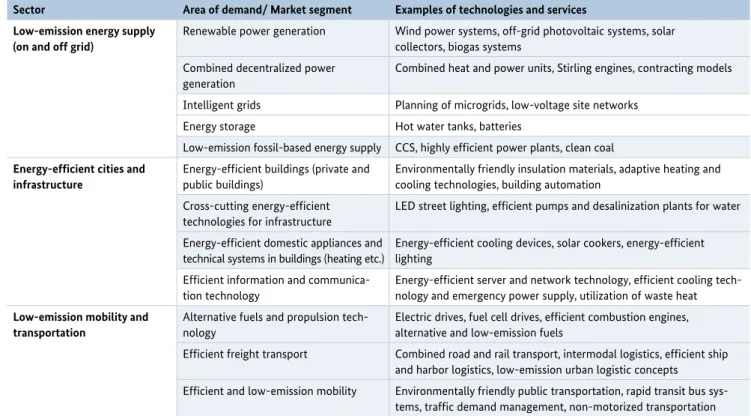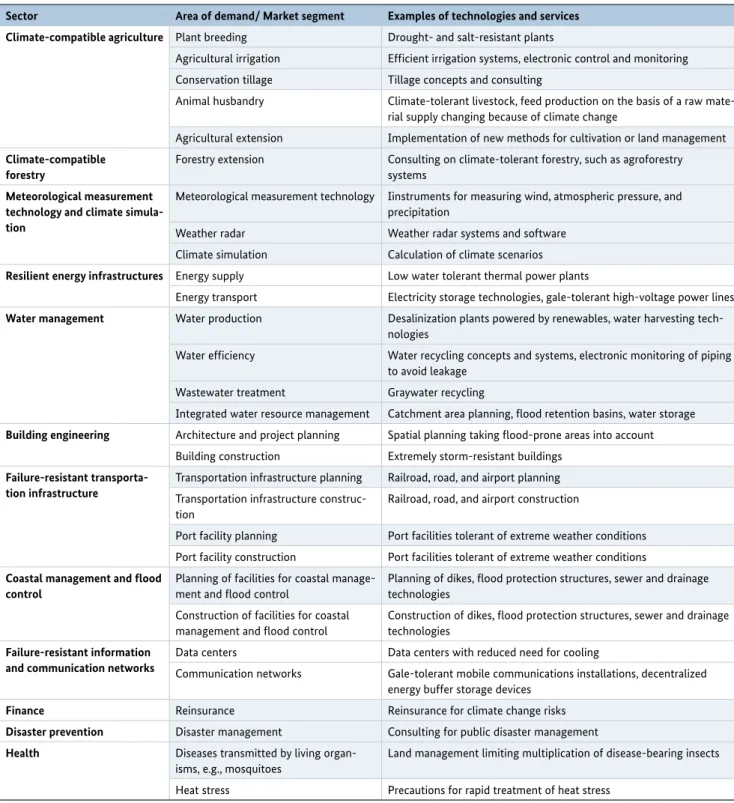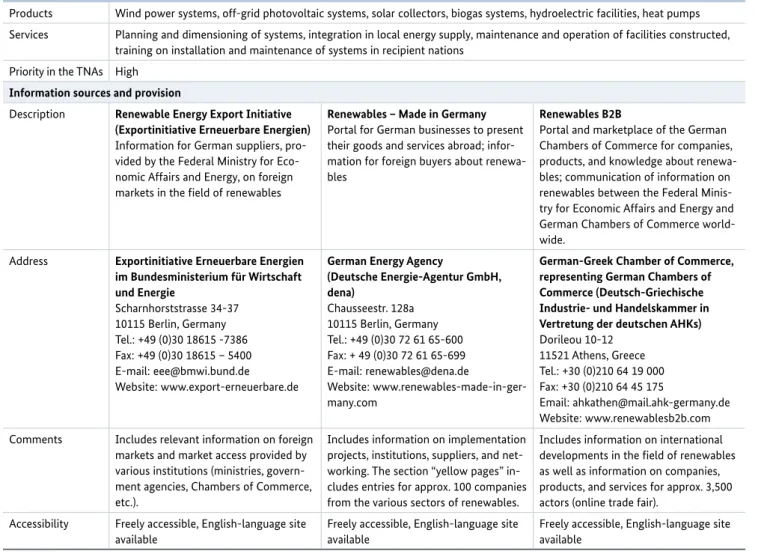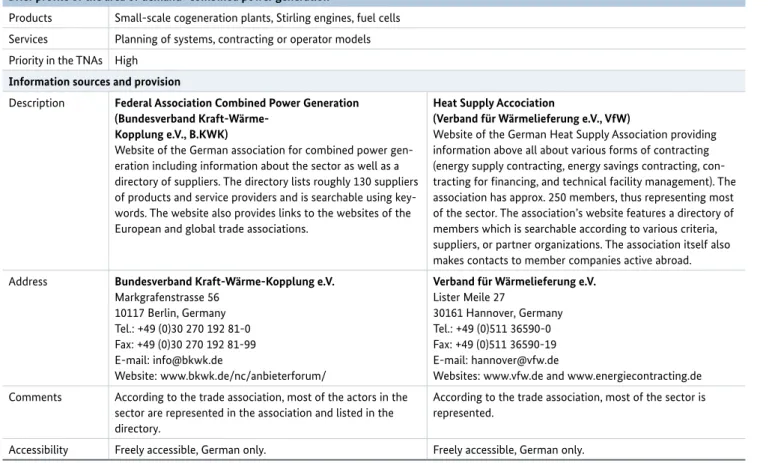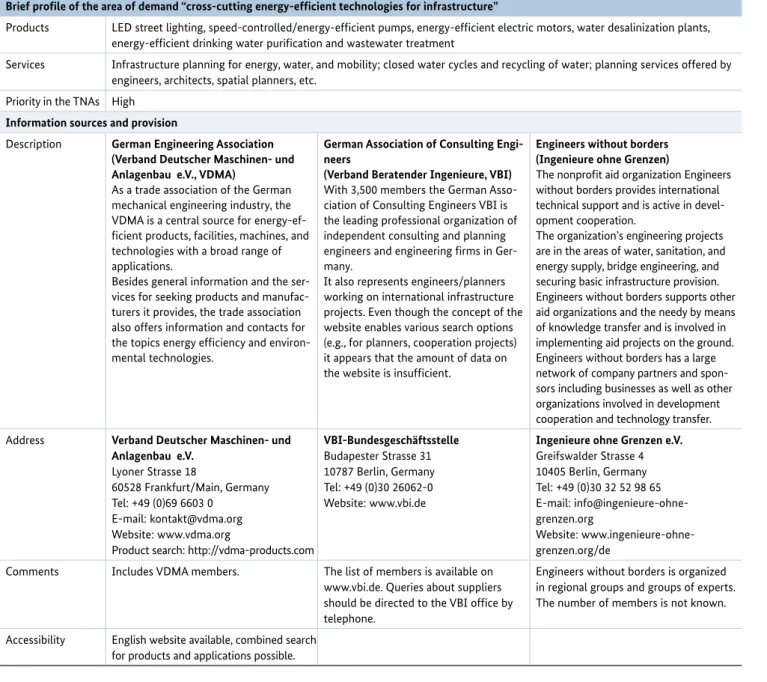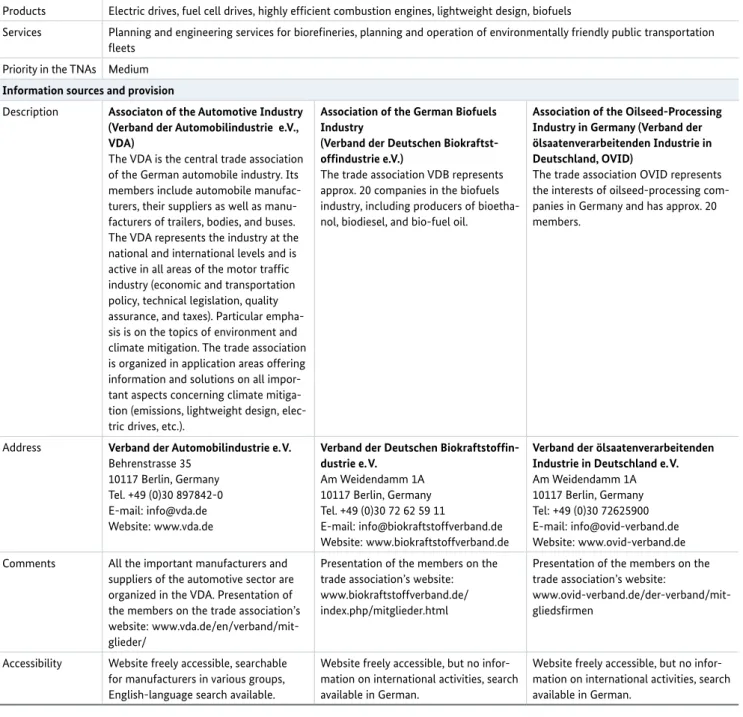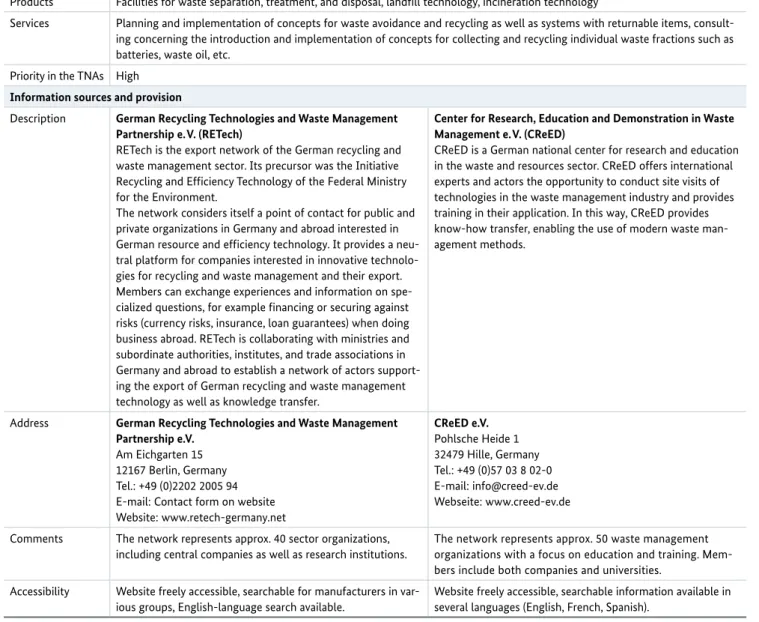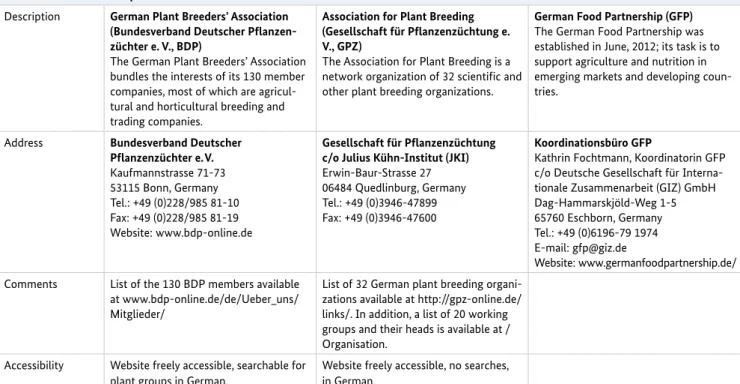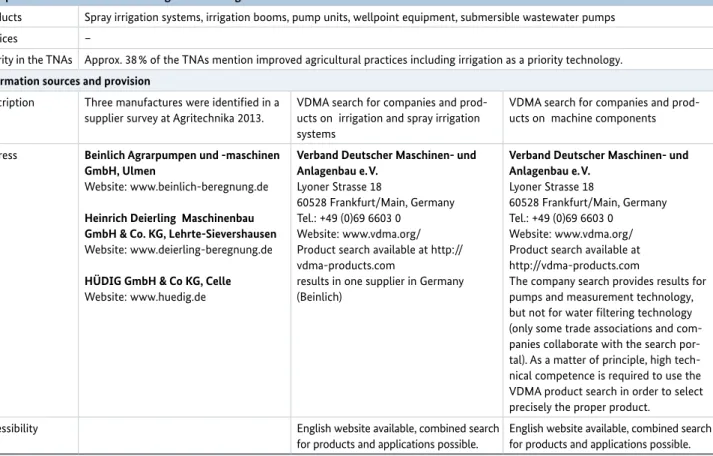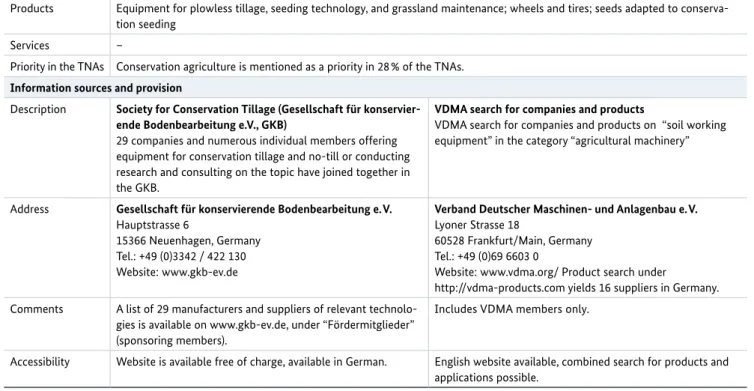Technologies and services for climate mitigation and adaptation from Germany Technologies and services
for climate mitigation and adaptation from Germany
Support for the UNFCCC Technology Mechanism provided by the German National Designated Entity
Support for the UNFCCC Technology Mechanism
provided by the German National Designated Entity
Imprint
Publisher
The Federal Ministry for Economic Affairs and Energy (BMWi) Public Relations
D-11019 Berlin, Germany www.bmwi.de
Design and production PRpetuum GmbH, Munich Status
November 2014 Print
Bonifatius GmbH, Paderborn
The present document is based on a study prepared for the Federal Ministry for Economic Affairs and Energy by the Borderstep Institute for Innovation and Sustainability in collaboration with the Forschungszentrum für Umweltpolitik (Environmental Policy Research Centre) of the Freie Universität Berlin and the Netzwerk für Innovation und Gründung im Klimawandel (NIK) of the Carl von Ossietzky University of Oldenburg.
Service project no. 15/13, commissioned by the German Federal Ministry for Economic Affairs and Energy Borderstep Institute
Dr. Severin Beucker Dr. Jens Clausen Prof. Dr. Klaus Fichter
Environmental Policy Research Centre, Freie Universität Berlin
Dr. Klaus Jacob Holger Bär
In cooperation with the Netzwerk Innovation und Gründung im Klimawandel (NIK) at the Carl von Ossietzky University of Oldenburg
Translation
Sandra H. Lustig, Hamburg Berlin, November 2014
This brochure is published as part of the public relations work of the Federal Ministry for Economic Affairs and Energy.
It is distributed free of charge and is not intended for sale. The distribution of this brochure at campaign events or at informa- tion stands run by political parties is prohibited, and political party-related information or advertising shall not be inserted in, printed on, or affixed to this publication.
The Federal Ministry for Economic Affairs and Energy was awarded the audit berufundfamilie® for its family-friendly staff policy. The certificate is conferred by the berufundfamilie gGmbH, an initiative of the non-profit Hertie Foundation.
This publication as well as further publications can be obtained from:
Federal Ministry for Economic Affairs and Energy (BMWi)
Public Relations
E-Mail: publikationen@bundesregierung.de www.bmwi.de
Central procurement service:
Tel.: +49 30 182722721 Fax: +49 30 18102722721
Technologies and services for climate mitigation and adaptation from Germany
Support for the UNFCCC Technology Mechanism
provided by the German National Designated Entity
2
Content
1 Goals of the study . . . .3
2 The structure of supply and demand for goods and services for climate mitigation and adaptation . . . .5
2.1 Typology for climate mitigation
. . . .5
2.2 Typology for climate adaptation
. . . .6
3 German goods and services . . . .8
3.1 Information provided in priority sectors and areas of demand
. . . .8
3.2 Brief profiles of individual sectors and areas of demand
. . . .8
3.3 Brief profiles of the priority sectors and areas of demand regarding climate mitigation
. . . .9
3.3.1 Low-emission energy supply (on and off grid)
. . . .9
3.3.2 Energy-efficient cities and infrastructure
. . . .11
3.3.3 Low-emission mobility and transportation
. . . .12
3.3.4 Energy- and resource-intensive industries
. . . .15
3.3.5 Sustainable waste management and circular economy
. . . .15
3.4 Brief profiles of the priority sectors and areas of demand regarding climate adaptation
. . . .17
3.4.1 Climate-compatible agriculture and forestry
. . . .17
3.4.2 Meteorological measurement technology and climate simulation
. . . .19
3.4.3 Water management
. . . .23
3.4.4 Engineering and architectural planning services
. . . .24
3.4.5 Reinsurance
. . . .25
3.4.6 Disaster management
. . . .25
3.4.7 Health
. . . .27
4 International cooperation in the climate context . . . .27
4.1 International cooperation with German involvement
. . . .27
4.2 Special aspects of cooperation concerning climate technologies
. . . .28
5 Concluding recommendations . . . .30
6 References . . . .32
3
1 Goals of the study
As the National Designated Entity (NDE) of Germany, the Federal Ministry for Economic Affairs and Energy supports the Climate Technology Centre and Network (CTCN) by providing and analyzing information on goods and ser- vices relating to climate-relevant technologies as well as demand for them and transfer mechanisms. The National Designated Entity serves as a point of contact for inquiries from abroad about German technology for climate mitiga- tion and adaptation and as a broker for establishing coop- eration with partners in Germany. One priority will be inquiries from emerging markets and developing countries, which are to enjoy special support in the context of the Technology Mechanism of the United Nations Framework Convention on Climate Change (UN FCCC).
For this purpose, an overview is required of relevant goods and services from Germany in the field of climate mitiga- tion and climate adaptation technologies that takes into account especially the needs in emerging markets and threshold countries and that enables access to technology transfer tools, actors, and institutions.
This publication provides that overview. It includes the fol- lowing information:
●
●
Technologies and services for climate mitigation and providers of such technologies and services in Germany;
●
●
Technologies and services for climate adaptation and providers of such technologies and services in Germany;
●
●
Cooperation activities involving German partners in the areas mentioned;
●
●
Activities for monitoring climate change (weather, etc.) with German involvement.
The following approach was selected to gather and present supply and demand for technologies and services for climate mitigation and adaptation appropriately:
●
●
In a first step, a typology was developed of the supply side in the areas of emission reduction and climate miti- gation as well as climate adaptation.
●
●
This structure was used as a basis for researching and documenting the economic significance, the important actors, and the addresses of German goods and service providers in the prioritized sectors and areas of demand.
In addition, an overview was prepared of climate research, weather monitoring activities, and cases of international cooperation with German involvement.
●
●
The Technology Needs Assessments (TNAs) and Synthe- sis Reports (UNFCCC 2009 and 2013) were evaluated in order to gather information about the demand side in the emerging markets and developing countries. In the future, the needs documented in the TNAs will be reflected in concrete demand, depending on the devel- opment of new international financial instruments.
Finally, recommendations for action to bring together sup- ply and demand were elaborated; they are presented in this publication only in condensed form. Please refer to the full version of the study for a more in-depth description (Beucker et al. 2014).
In the present publication, the following central results are presented on the basis of the approach selected:
(1) the structure of the goods and services for climate miti- gation and adaptation provided by Germany and inter- national demand for them;
(2) the evaluation of existing German goods and services and experiences with technology transfer and capacity building; and
(3) recommendations resulting from these results for the future design of the Technology Mechanism.
The central insights concerning supply and demand for
climate technologies and services are summarized in the
following sections.
GOALS OF THE STUDY 44
The National Designated Entity of Germany
The UNFCCC’s Technology Mechanism is composed of a policy unit – the Technology Executive Committee (TEC), and an implementing unit – the Climate Technology Centre and Network (CTCN). At national level, the CTCN is supported by national contact points (National Designated Entities – NDEs). The tasks of the German NDE are overseen by the Federal Ministry for Economic Affairs and Energy. The German NDE serves as the first point of contact for all enquiries about technology cooperation with German companies, research institutions and the public sector. Where appropriate, informa- tion about envisaged research projects and technologies from Germany is passed on to the CTCN, and enquiries from the CTCN and from developing countries and emerging economies are compiled and sent on accordingly.
Contact
Federal Ministry for Economic Affairs and Energy Division IVC2 – Climate Change and International Environmental Policy
Scharnhorststraße 34-37 10115 Berlin, Germany Tel. +49 (30) 18615 7468
E-Mail: NDE-Germany@bmwi.bund.de
www.nde-germany.de
5
2 The structure of supply and demand for goods and services for climate mitigation and adaptation
2.1 Typology for climate mitigation
The structure of the supply side in the areas of emission reduction and climate mitigation can be ascertained easily using existing approaches for gathering data about the environmental industry in Germany. A classification in sec- tors and areas of demand/market segments was selected against the background of already existing approaches to structuring (see, e. g., Weiß & Fichter 2013) and also with a view to its translatability into concrete demands and satis- fying them. The analysis of the demand side, however, proved to be more complex. Since the goal was especially to capture new, potential demands in various countries as well as in the different fields of application, it would not have sufficed to rely on existing catalogs of available goods and services. Instead, demand-related solutions for emerg- ing markets and developing countries were also taken into account, as presented, e. g., in the Technology Needs Assess- ments (TNAs) and their Synthesis Reports (UNFCCC 2009
und 2013). In the field of climate mitigation, 14 areas of demand were identified in this way where technologies and services supplied by German suppliers match the demands in emerging markets and developing countries well.
Table 1 shows the combined results of the analyses of both supply and areas of demand as well as the weighting of the priorities for technology transfer. The supply side, i.e., the sectors and areas of demand in which German suppliers can make a contribution to technology transfer to emerg- ing markets and developing countries by means of technol- ogies, products, and services, was weighted in a multi-step process. It took account of both the initial position of Ger- man suppliers in the field and expected market develop- ment in Germany as well as various regions of the world
1. Therefore, the typologies developed for climate mitigation as well as for adaptation fulfill an important brokering function in that they allocate goods and services supplied and demanded to distinct solutions.
1 The methodology is described in detail in the full version of the final report of this study (Beucker et al. 2014).
Table 1: Structuring approach to gathering data about goods and services on offer for climate mitigation and emission reductions
Sector Area of demand/ Market segment Examples of technologies and services Low-emission energy supply
(on and off grid)
Renewable power generation Wind power systems, off-grid photovoltaic systems, solar collectors, biogas systems
Combined decentralized power generation
Combined heat and power units, Stirling engines, contracting models
Intelligent grids Planning of microgrids, low-voltage site networks
Energy storage Hot water tanks, batteries
Low-emission fossil-based energy supply CCS, highly efficient power plants, clean coal Energy-efficient cities and
infrastructure
Energy-efficient buildings (private and public buildings)
Environmentally friendly insulation materials, adaptive heating and cooling technologies, building automation
Cross-cutting energy-efficient technologies for infrastructure
LED street lighting, efficient pumps and desalinization plants for water
Energy-efficient domestic appliances and technical systems in buildings (heating etc.)
Energy-efficient cooling devices, solar cookers, energy-efficient lighting
Efficient information and communica- tion technology
Energy-efficient server and network technology, efficient cooling tech- nology and emergency power supply, utilization of waste heat Low-emission mobility and
transportation
Alternative fuels and propulsion tech- nology
Electric drives, fuel cell drives, efficient combustion engines, alternative and low-emission fuels
Efficient freight transport Combined road and rail transport, intermodal logistics, efficient ship and harbor logistics, low-emission urban logistic concepts
Efficient and low-emission mobility Environmentally friendly public transportation, rapid transit bus sys- tems, traffic demand management, non-motorized transportation
6
Sector Area of demand/ Market segment Examples of technologies and services Energy- and resource-intensive
industries
Efficient production methods and processes
Energy-efficient production and automation technology, speed- controlled electric motors, efficient compressed air generation, low-emission process heat generation and combustion technology Planning of efficient and integrated
production concepts
Planning of integrated, energy-efficient production sites and chains, planning and implementation of coupled production and eco-industry parks
Material- and energy-efficient product design
Efficient product design with regard to raw materials and energy, eco-design concepts
Substitution of fossil resources by renewable resources
Substitution of fossil resources by cellulose, starch, and lactic acid, use of oils and fats from renewables
Sustainable waste manage- ment and circular economy
Waste avoidance Planning and implementation of systems with returnable items, con- sulting for planning and implementation of waste avoidance concepts Waste collection and treatment Landfill gas capture, waste sorting plants, waste separation concepts,
low-emission waste incineration, composting and biogas systems Environmentally friendly recycling
concepts
Planning of regional recycling concepts, implementation of specific recycling approaches, e.g., for electronic scrap or waste oil Climate-friendly agriculture
and forestry
Climate-friendly agriculture Low-emission fertilizing, energy-efficient and emissions-reducing cultivation technologies
Climate-friendly forestry (Re-)forestation, energy-efficient and emissions-reducing management technologies
Cross-sectoral cross-cutting technologies for reducing emissions
Reduction of air pollutants and other greenhouse gases
Flue gas particulate collector technology, NOx catalytic converters, capturing mining methane
Substitution of basic commodities and chemicals harmful to the climate
Replacement of refrigerants harmful to the climate, substitution of laughing gas
Miscellaneous services Financing concepts for climate mitiga- tion solutions
Development of technology- and country-specific financing concepts for products and services for reducing emissions Policy development and consulting Support and consulting for introducing and implementing the
German Renewable Energy Sources Act (EEG), emission reduction standards, etc.
Training and education for climate mitigation
Training measures accompanying products and services for reducing emissions
Source: authors.
(Areas of demand/market segments/solutions that were prioritized both on the supply side (Germany) and on the demand side (emerging markets and developing countries) are shaded.)
2.2 Typology for climate adaptation
Climate change is bringing about different demands for adaptation in the individual regions and countries, but also in the various sectors within countries. With a view to tech- nologies and services for climate adaptation, it makes sense to develop a suitable structure by focusing on those sectors of the economy and of demand with a high likelihood of being affected most strongly by the changes. The TNAs (UNFCCC 2009 and 2013) provide a starting point for struc- turing markets to adapt to climate change. Using the TNAs
as a basis, a total of 12 areas of demand were identified in which products or services relevant for climate adaptation can be supplied. Demands identified and prioritized in the TNAs can be allocated to each of these sectors. The number of areas of demand is relatively high in the agriculture and forestry sector due to its high number of climate-depend- ent functions; in all other sectors, it was significantly lower (see table 2).
The procedure was analogous to the steps described in the
section on climate mitigation above.
77
Table 2: Structuring approach to gathering data about goods and services on offer for climate adaptation
Sector Area of demand/ Market segment Examples of technologies and services Climate-compatible agriculture Plant breeding Drought- and salt-resistant plants
Agricultural irrigation Efficient irrigation systems, electronic control and monitoring Conservation tillage Tillage concepts and consulting
Animal husbandry Climate-tolerant livestock, feed production on the basis of a raw mate- rial supply changing because of climate change
Agricultural extension Implementation of new methods for cultivation or land management Climate-compatible
forestry
Forestry extension Consulting on climate-tolerant forestry, such as agroforestry systems
Meteorological measurement technology and climate simula- tion
Meteorological measurement technology Iinstruments for measuring wind, atmospheric pressure, and precipitation
Weather radar Weather radar systems and software
Climate simulation Calculation of climate scenarios Resilient energy infrastructures Energy supply Low water tolerant thermal power plants
Energy transport Electricity storage technologies, gale-tolerant high-voltage power lines Water management Water production Desalinization plants powered by renewables, water harvesting tech-
nologies
Water efficiency Water recycling concepts and systems, electronic monitoring of piping to avoid leakage
Wastewater treatment Graywater recycling
Integrated water resource management Catchment area planning, flood retention basins, water storage Building engineering Architecture and project planning Spatial planning taking flood-prone areas into account
Building construction Extremely storm-resistant buildings Failure-resistant transporta-
tion infrastructure
Transportation infrastructure planning Railroad, road, and airport planning Transportation infrastructure construc-
tion
Railroad, road, and airport construction
Port facility planning Port facilities tolerant of extreme weather conditions Port facility construction Port facilities tolerant of extreme weather conditions Coastal management and flood
control
Planning of facilities for coastal manage- ment and flood control
Planning of dikes, flood protection structures, sewer and drainage technologies
Construction of facilities for coastal management and flood control
Construction of dikes, flood protection structures, sewer and drainage technologies
Failure-resistant information and communication networks
Data centers Data centers with reduced need for cooling
Communication networks Gale-tolerant mobile communications installations, decentralized energy buffer storage devices
Finance Reinsurance Reinsurance for climate change risks
Disaster prevention Disaster management Consulting for public disaster management Health Diseases transmitted by living organ-
isms, e.g., mosquitoes
Land management limiting multiplication of disease-bearing insects
Heat stress Precautions for rapid treatment of heat stress
Source: authors.
(Demand areas/market segments/solutions that were prioritized both on the supply side (Germany) and on the demand side (emerging markets and developing countries) are shaded.)
8
3 German goods and services
3.1 Information provided in priority sectors and areas of demand
To provide input to the technology mechanisms, it is nec- essary to broker supply and demand and also to approach sector- or industry-specific organizations and intermediar- ies whose knowledge of the industry is as comprehensive as possible and who may also possess experience with tech- nology transfer. To enable this, information sources were researched that offer simplified access to German providers of technologies, products, and services for climate mitiga- tion and adaptation.
The tables below present brief profiles of the information sources in these sectors, information on goods and services (examples) in the individual areas of demand, and – where possible – different contact options.
In principle, the German business community is well-posi- tioned in many sectors and areas of demand with its range of products and services for climate mitigation and adapta- tion. This allows to compile lists with large numbers of existing suppliers with diversified products and services in numerous relevant sectors and areas of demand.
In addition to the industries in which Germany has a strong economic position – e.g., climate-friendly power generation and energy efficiency with the corresponding export initiatives – other sectors, such as water and waste management, stand out because of their particularly com- prehensive export and transfer initiatives. The German Water Partnership, the German Recycling Technologies and Waste Management Partnership (RETech), the Center for Research, Education and Demonstration in Waste Manage- ment (CReED), and the Export Initiative Energy Efficiency all successfully combine the goal of economic cooperation with emerging markets and developing countries with approaches for education, qualification, financing, and con- sulting.
Germany possesses strong ranges of goods and services in other sectors as well, e.g. resilient energy infrastructures, cross-sector cross-cutting technologies, and in the areas of demand energy storage systems and intelligent grid expan- sion. However, no concrete indications of demand from emerging markets and developing countries could be iden- tified for these areas. There may be several reasons for this:
For one thing, this could be interpreted as an indication that emerging markets and developing countries are first focusing on meeting central needs in agriculture, energy
supply, and mobility, which is why they do not mention more complex products, technologies, and high-tech solu- tions dependent on infrastructure and long-term financ- ing. For another, it could be an indication of the major challenges (financing, qualification, etc.) involved with the transfer of such goods and services. Although the long- term effects of such solutions offer substantial synergies and other potential benefits for the countries, which is clearly visible in the example of intelligent grid expansion and climate-compatible infrastructure, those effects must also be embedded in the relevant concepts for planning, financing, education and training. That is the reason why it may be necessary to initiate further and concerted initia- tives, especially for the transfer of complex planning and high-tech solutions.
It should be noted at this point that the methods applied in the underlying study of this publication do not permit quantitative estimates of market volumes or assessments of the market dynamics or the ranges of products and services in other countries. However, the tables in the previous chapter do help to briefly characterize the areas of demand with the products and services offered in each. They also contain additional information sources and name institu- tions that can provide support for seeking out potential suppliers of German products and services.
3.2 Brief profiles of individual sectors and areas of demand
The following brief profiles compile information on the sectors and areas of demand for climate mitigation and adaptation shaded in green in Tables 1 and 2.
They provide an overview of products and services, explain how priorities were set in the TNAs, and list information about suppliers. In addition, the websites of the organiza- tions mentioned were evaluated, and selected representa- tives of trade associations and companies were interviewed by telephone. In this way, it was possible to determine which points of access to information about products, ser- vices, and consulting in the individual sectors and areas of demand exist. Fundamentally speaking, three cases have been differentiated:
1. Lists of members of trade associations exist, and they
can be searched for companies providing concrete prod-
ucts, for example, the comprehensive VDMA databases.
GERMAN GOODS AND SERVICES 9
2. Export initiatives exist in some sectors, e.g. renewables or water management, in some cases in addition to data- bases. In individual cases, they even enable differenti- ated searches for products and countries to which the supplier is prepared to deliver.
3. No trade associations or similar structures exist which compile and update lists of suppliers. In the few (often small) priority sectors of this type, the usually small num bers of suppliers were identified to the extent possi- ble.
The brief profiles of the areas of demand are presented in the form of tables. The data sources were evaluated on the basis of the information accessible. In the category “Com- ments,” information is given on the focus and the amount of data, and any discernable limitations are noted as well (e.g., that the database includes members of the trade asso- ciation only). The category “accessibility” includes informa- tion about whether the database is accessible to the public and in English, or whether any other restrictions are in place.
2Brief profiles were not compiled for the sector “miscellane- ous services for climate mitigation” and its areas of demand
“financing concepts,” “policy development and consulting,”
as well as “training and education for climate mitigation”
because of their cross-cutting nature, the large number of actors involved, and the resulting opportunities for cooper- ation. Because of the fundamental importance for interna- tional cooperation, the section on recommendations in the full report discusses the opportunities and challenges in this sector (see Beucker et al. 2014).
3.3 Brief profiles of the priority sectors and areas of demand regarding climate mitigation
3.3.1 Low-emission energy supply (on and off grid) The sector “low-emission energy supply (on and off grid)”
encompasses the areas of demand “renewables,” “combined decentralized power generation,” “intelligent grids,” “energy storage” as well as “low-emission fossil-based energy sup- ply.” Brief profiles for the areas of demand “intelligent grids” and “energy storage” were not prepared because the TNAs did not include demand corresponding to them at all or demand corresponding well.
3 .3 .1 .1 Renewable power generation
In the area of demand “renewable power generation,” there are several information services or platforms relevant for brokering products and services. This is due to the strength of German providers in this area. The platforms mentioned below, namely the Renewable Energy Export Initiative, Renewables Made in Germany, and Renewables B2B, are the three central platforms of the Federal Ministry for Eco- nomic Affairs and Energy in this field. According to infor- mation provided by the Renewable Energy Export Initiative in March 2014, they are currently under revision and will be combined into a single platform.
Besides the information sources mentioned, there is also information on target markets for renewables provided by Germany Trade and Invest (GTAI) as well as further sup- plier directories provided by trade associations (e.g., Ger- man Renewable Energy Federation [BEE], German Wind Energy Association [BWE], German Solar Industry Associa- tion [BSW], VGB PowerTech, etc.). Because of the large number of individual trade associations, a list of all the directories provided by all the associations was not com- piled. Instead, efforts were concentrated on initiatives spanning associations and focusing on exports.
2 Additional information on the sectors and areas of demand as well as somewhat more comprehensive profiles are to be found in the final repor t of the study (Beucker et al. 2014).
GERMAN GOODS AND SERVICES 10
Table 3: Brief profile of the area of demand “renewable power generation”
Brief profile of the area of demand “renewable power generation”
Products Wind power systems, off-grid photovoltaic systems, solar collectors, biogas systems, hydroelectric facilities, heat pumps Services Planning and dimensioning of systems, integration in local energy supply, maintenance and operation of facilities constructed,
training on installation and maintenance of systems in recipient nations Priority in the TNAs High
Information sources and provision
Description Renewable Energy Export Initiative (Exportinitiative Erneuerbare Energien) Information for German suppliers, pro- vided by the Federal Ministry for Eco- nomic Affairs and Energy, on foreign markets in the field of renewables
Renewables – Made in Germany Portal for German businesses to present their goods and services abroad; infor- mation for foreign buyers about renewa- bles
Renewables B2B
Portal and marketplace of the German Chambers of Commerce for companies, products, and knowledge about renewa- bles; communication of information on renewables between the Federal Minis- try for Economic Affairs and Energy and German Chambers of Commerce world- wide.
Address Exportinitiative Erneuerbare Energien im Bundesministerium für Wirtschaft und Energie
Scharnhorststrasse 34-37 10115 Berlin, Germany Tel.: +49 (0)30 18615 -7386 Fax: +49 (0)30 18615 – 5400 E-mail: eee@bmwi.bund.de Website: www.export-erneuerbare.de
German Energy Agency
(Deutsche Energie-Agentur GmbH, dena)
Chausseestr. 128a 10115 Berlin, Germany Tel.: +49 (0)30 72 61 65-600 Fax: + 49 (0)30 72 61 65-699 E-mail: renewables@dena.de
Website: www.renewables-made-in-ger- many.com
German-Greek Chamber of Commerce, representing German Chambers of Commerce (Deutsch-Griechische Industrie- und Handelskammer in Vertretung der deutschen AHKs) Dorileou 10-12
11521 Athens, Greece Tel.: +30 (0)210 64 19 000 Fax: +30 (0)210 64 45 175
Email: ahkathen@mail.ahk-germany.de Website: www.renewablesb2b.com Comments Includes relevant information on foreign
markets and market access provided by various institutions (ministries, govern- ment agencies, Chambers of Commerce, etc.).
Includes information on implementation projects, institutions, suppliers, and net- working. The section “yellow pages” in- cludes entries for approx. 100 companies from the various sectors of renewables.
Includes information on international developments in the field of renewables as well as information on companies, products, and services for approx. 3,500 actors (online trade fair).
Accessibility Freely accessible, English-language site available
Freely accessible, English-language site available
Freely accessible, English-language site available
3 .3 .1 .2 Combined decentralized power generation
The area of demand “combined decentralized power gen- eration” (table 4) is represented by two trade associations, the Federal Association Combined Power Generation (Bundesverband Kraft-Wärme-Kopplung), most of whose members are manufacturers of technical components for combined power generation, and the Heat Supply Associa- tion (Verband für Wärmelieferung) in which service pro- viders and companies providing energy contracting are organized.
3 .3 .1 .3 Low-emission fossil-based energy supply
The area of demand “low-emission, fossil-based energy
supply” (table 5) is dominated by a few large trade associa-
tions because of the structure of the sector and the indus-
try (mostly large companies operating internationally). The
central actor is the European technical trade association
VGB PowerTech, which has European and international
members and cooperation partners and is well integrated
in an international network. Besides traditional power
plant technology, the trade association is also concerned
with the field of renewables; the focus here is more on
large power plants (e.g., hydroelectric plants) and the tech-
nology and planning they involve.
GERMAN GOODS AND SERVICES 11
Table 4: Brief profile of the area of demand “combined power generation”
Brief profile of the area of demand “combined power generation”
Products Small-scale cogeneration plants, Stirling engines, fuel cells Services Planning of systems, contracting or operator models Priority in the TNAs High
Information sources and provision
Description Federal Association Combined Power Generation (Bundesverband Kraft-Wärme-
Kopplung e.V., B.KWK)
Website of the German association for combined power gen- eration including information about the sector as well as a directory of suppliers. The directory lists roughly 130 suppliers of products and service providers and is searchable using key- words. The website also provides links to the websites of the European and global trade associations.
Heat Supply Accociation
(Verband für Wärmelieferung e.V., VfW)
Website of the German Heat Supply Association providing information above all about various forms of contracting (energy supply contracting, energy savings contracting, con- tracting for financing, and technical facility management). The association has approx. 250 members, thus representing most of the sector. The association’s website features a directory of members which is searchable according to various criteria, suppliers, or partner organizations. The association itself also makes contacts to member companies active abroad.
Address Bundesverband Kraft-Wärme-Kopplung e.V.
Markgrafenstrasse 56 10117 Berlin, Germany Tel.: +49 (0)30 270 192 81-0 Fax: +49 (0)30 270 192 81-99 E-mail: info@bkwk.de
Website: www.bkwk.de/nc/anbieterforum/
Verband für Wärmelieferung e.V.
Lister Meile 27
30161 Hannover, Germany Tel.: +49 (0)511 36590-0 Fax: +49 (0)511 36590-19 E-mail: hannover@vfw.de
Websites: www.vfw.de and www.energiecontracting.de Comments According to the trade association, most of the actors in the
sector are represented in the association and listed in the directory.
According to the trade association, most of the sector is represented.
Accessibility Freely accessible, German only. Freely accessible, German only.
3.3.2 Energy-efficient cities and infrastructure The sector “energy-efficient cities and infrastructure” in- cludes the areas of demand “energy-efficient cross-cutting technologies for infrastructure” as well as “energy-efficient domestic appliances and technical systems in buildings (heating systems etc.).” Nothing corresponding to the area of demand “efficient ICT” was to be found in the TNAs. For this reason, a brief profile of this area of demand was not prepared.
3 .3 .2 .1 Cross-cutting energy-efficient technologies for infrastructure
The area of demand “cross-cutting energy-efficient tech- nologies for infrastructure” (table 6) includes various tech- nologies and sectors that may be employed for energy- and resource-efficient infrastructure. It is difficult to allocate suppliers and their organizations in this field because it
involves a large number of industry sectors. Besides techni- cal solutions and products, planning services must be taken into account in this area of demand.
3 .3 .2 .2 Energy-efficient domestic appliances and techni- cal systems in buildings (heating systems etc .)
The area of demand “energy-efficient domestic appliances and technical systems in buildings (heating systems etc.)”
(table 7) includes various products and technologies that
are used by end consumers, mostly in homes. Services are
practically not provided at all in this area of demand. Even
though the initial position of German suppliers in this area
of demand is good, it has yet to be clarified whether the
products on offer match the specific needs on the demand
side (this is true, e.g., of emerging markets and developing
countries where stable electricity supply is not available
around the clock or where other techniques are used for
cooking).
GERMAN GOODS AND SERVICES 12
Because of the proximity to end consumers and the large number of product suppliers operating globally, there are only a few usable information sources that can meaning- fully be allocated to this area of demand.
3.3.3 Low-emission mobility and transportation The sector includes the areas of demand “alternative fuels and propulsion technology,” “efficient freight transport,” as well as “efficient and low-emission mobility.” Brief profiles of all areas of demand were compiled because of the corre- sponding demands formulated in the TNAs.
3 .3 .3 .1 Alternative fuels and propulsion technology
The area of demand “alternative fuels and propulsion tech- nology” (table 8) comprises products and services required for low-emission mobility and transport. Besides tradi- tional, but efficient, combustion engines, they also include alternative propulsion technologies such as electric motors, fuel cells, and hybrid drives, as well as alternative fuels, for example biodiesel.
Table 5: Brief profile of the area of demand “low-emission fossil-based energy supply”
Brief profile of the area of demand “low-emission fossil-based energy supply”
Products Efficient fuel and firing technology, gas and steam turbines, steam generators, turbines Services Consulting, planning/design, and realization of power plants and their technology Priority in the TNAs High
Information sources and provision
Description European technical association for electricity and heat generation
(VGB PowerTech e.V. – Europäischer technischer Fach- verband für die Strom- und Wärmeerzeugung)
European technical association for electricity and heat genera- tion. Association of companies in the sector of power plant operations and the associated technology. The trade associa- tion’s activities include exchange and transfer of technical know-how, definition of technical and operational standards as well as identification and organization of joint R&D activi- ties.
The trade association has a directory of members on its web- site (see http://www.vgb.org/en/vgb_memberlist.html); mem- bers are grouped as ordinary, associate, and sponsoring mem- bers. In addition, experts can be identified in the category
“contact” by searching with keywords (see http://www.vgb.
org/en/vgb_contact.html).
German Association of Energy and Water Industries (Bundesverband der Energie- und Wasserwirtschaft e.V., BDEW)
The BDEW is the central association for companies in the sectors natural gas, electricity, and district heating as well as water and wastewater. The companies represented in the BDEW are both local and municipal companies and suprare- gional ones. They represent roughly 90 percent of electricity sales, approximately 60 percent of local and district heating sales, and 90 percent of natural gas sales in Germany. The trade association and its members operate in the various fields of the energy sector and cooperate internationally with orga- nizations in the energy and water sectors.
In the context of the transformation of the energy system, the BDEW plays an important role, as economic, legal, and techni- cal questions of the transformation of the energy supply are coordinated through it. It provides support by conducting mar- ket research and offering business consulting and legal con- sulting services. This experience in implementation may be highly relevant for technology transfer.
Address VGB PowerTech e. V.
Klinkestrasse 27-31 45136 Essen, Germany Tel: +49 (0)2 01 81 28-0 E-Mail: info@vgb.org Website: www.vgb.org
BDEW Bundesverband der Energie- und Wasserwirtschaft e. V.
Reinhardtstrasse 32 10117 Berlin, Germany Tel: +49 (0)30 300 199-0 E-mail: info@bdew.de Website: www.bdew.de Comments The headquarters of the trade association are located in Ger-
many. The association has 483 member companies, including operators, manufacturers, and other actors in electricity and heat generation. The members are from 34 countries.
The trade association has more than 1,800 members and represents a significant part of Germany’s energy sector.
To date, one focus has been on representing the interests of the German members.
Accessibility Freely accessible, information available in German and English. Freely accessible, most of the information is in German.
GERMAN GOODS AND SERVICES 13
Table 6: Brief profile of the area of demand “cross-cutting energy-efficient technologies for infrastructure”
Brief profile of the area of demand “cross-cutting energy-efficient technologies for infrastructure”
Products LED street lighting, speed-controlled/energy-efficient pumps, energy-efficient electric motors, water desalinization plants, energy-efficient drinking water purification and wastewater treatment
Services Infrastructure planning for energy, water, and mobility; closed water cycles and recycling of water; planning services offered by engineers, architects, spatial planners, etc.
Priority in the TNAs High Information sources and provision
Description German Engineering Association (Verband Deutscher Maschinen- und Anlagenbau e.V., VDMA)
As a trade association of the German mechanical engineering industry, the VDMA is a central source for energy-ef- ficient products, facilities, machines, and technologies with a broad range of applications.
Besides general information and the ser- vices for seeking products and manufac- turers it provides, the trade association also offers information and contacts for the topics energy efficiency and environ- mental technologies.
German Association of Consulting Engi- neers
(Verband Beratender Ingenieure, VBI) With 3,500 members the German Asso- ciation of Consulting Engineers VBI is the leading professional organization of independent consulting and planning engineers and engineering firms in Ger- many.
It also represents engineers/planners working on international infrastructure projects. Even though the concept of the website enables various search options (e.g., for planners, cooperation projects) it appears that the amount of data on the website is insufficient.
Engineers without borders (Ingenieure ohne Grenzen)
The nonprofit aid organization Engineers without borders provides international technical support and is active in devel- opment cooperation.
The organization’s engineering projects are in the areas of water, sanitation, and energy supply, bridge engineering, and securing basic infrastructure provision.
Engineers without borders supports other aid organizations and the needy by means of knowledge transfer and is involved in implementing aid projects on the ground.
Engineers without borders has a large network of company partners and spon- sors including businesses as well as other organizations involved in development cooperation and technology transfer.
Address Verband Deutscher Maschinen- und Anlagenbau e.V.
Lyoner Strasse 18
60528 Frankfurt/Main, Germany Tel: +49 (0)69 6603 0
E-mail: kontakt@vdma.org Website: www.vdma.org
Product search: http://vdma-products.com
VBI-Bundesgeschäftsstelle Budapester Strasse 31 10787 Berlin, Germany Tel: +49 (0)30 26062-0 Website: www.vbi.de
Ingenieure ohne Grenzen e.V.
Greifswalder Strasse 4 10405 Berlin, Germany Tel: +49 (0)30 32 52 98 65 E-mail: info@ingenieure-ohne- grenzen.org
Website: www.ingenieure-ohne- grenzen.org/de
Comments Includes VDMA members. The list of members is available on www.vbi.de. Queries about suppliers should be directed to the VBI office by telephone.
Engineers without borders is organized in regional groups and groups of experts.
The number of members is not known.
Accessibility English website available, combined search for products and applications possible.
Table 7: Brief profile of the area of demand “energy-efficient domestic appliances and technical systems in buildings (heating systems etc.)”
Brief profile of the area of demand “energy-efficient domestic appliances and technical systems in buildings (heating systems etc.)”
Products Energy-efficient refrigerators, small/decentralized air conditioners, energy-saving heaters and cookers (solar cookers), energy-efficient lighting
Services No specific services available Priority in the TNAs High
Information sources and provision
Description The German Energy Agency DENA provides an information portal of the Initiative Energieeffizienz (Initiative Energy Efficiency).
General information about the energy efficiency of domestic appliances is available on www.stromeffizienz.de; this information does not favor any particular manufacturer and is oriented toward German end consumers.
Export-oriented information on individual technologies (e.g., solar cookers or solar lighting) can be found in assessments and market studies on the export initiative’s website (www.renewablesb2b.com/).
GERMAN GOODS AND SERVICES 14
Table 8: Brief profile of the area of demand “alternative fuels and propulsion technologies”
Brief profile of the area of demand “alternative fuels and propulsion technologies”
Products Electric drives, fuel cell drives, highly efficient combustion engines, lightweight design, biofuels
Services Planning and engineering services for biorefineries, planning and operation of environmentally friendly public transportation fleets
Priority in the TNAs Medium Information sources and provision
Description Associaton of the Automotive Industry (Verband der Automobilindustrie e.V., VDA)
The VDA is the central trade association of the German automobile industry. Its members include automobile manufac- turers, their suppliers as well as manu- facturers of trailers, bodies, and buses.
The VDA represents the industry at the national and international levels and is active in all areas of the motor traffic industry (economic and transportation policy, technical legislation, quality assurance, and taxes). Particular empha- sis is on the topics of environment and climate mitigation. The trade association is organized in application areas offering information and solutions on all impor- tant aspects concerning climate mitiga- tion (emissions, lightweight design, elec- tric drives, etc.).
Association of the German Biofuels Industry
(Verband der Deutschen Biokraftst- offindustrie e.V.)
The trade association VDB represents approx. 20 companies in the biofuels industry, including producers of bioetha- nol, biodiesel, and bio-fuel oil.
Association of the Oilseed-Processing Industry in Germany (Verband der ölsaatenverarbeitenden Industrie in Deutschland, OVID)
The trade association OVID represents the interests of oilseed-processing com- panies in Germany and has approx. 20 members.
Address Verband der Automobilindustrie e. V.
Behrenstrasse 35 10117 Berlin, Germany Tel. +49 (0)30 897842-0 E-mail: info@vda.de Website: www.vda.de
Verband der Deutschen Biokraftstoffin- dustrie e. V.
Am Weidendamm 1A 10117 Berlin, Germany Tel. +49 (0)30 72 62 59 11
E-mail: info@biokraftstoffverband.de Website: www.biokraftstoffverband.de
Verband der ölsaatenverarbeitenden Industrie in Deutschland e. V.
Am Weidendamm 1A 10117 Berlin, Germany Tel: +49 (0)30 72625900 E-mail: info@ovid-verband.de Website: www.ovid-verband.de Comments All the important manufacturers and
suppliers of the automotive sector are organized in the VDA. Presentation of the members on the trade association’s website: www.vda.de/en/verband/mit- glieder/
Presentation of the members on the trade association’s website:
www.biokraftstoffverband.de/
index.php/mitglieder.html
Presentation of the members on the trade association’s website:
www.ovid-verband.de/der-verband/mit- gliedsfirmen
Accessibility Website freely accessible, searchable for manufacturers in various groups, English-language search available.
Website freely accessible, but no infor- mation on international activities, search available in German.
Website freely accessible, but no infor- mation on international activities, search available in German.
3 .3 .3 .2 Efficient freight transport
The area of demand “efficient freight transport” (table 9) includes products and services for environmentally friendly and energy-efficient freight transport. Depending on the type, properties, and urgency of the goods to be transported, various transport media (truck, rail, ship, plane, etc.) or com- binations of these media can be employed.
3 .3 .3 .3 Efficient and low-emission mobility
The area of demand “efficient and low-emission mobility”
(table 10) includes products and services for environmen-
tally friendly passenger services, e. g., public transportation
solutions, non-motorized concepts for local transportation,
or technologies and systems for smooth traffic flow.
GERMAN GOODS AND SERVICES 15
Table 9: Brief profile of the area of demand “efficient freight transport”
Brief profile of the area of demand “efficient freight transport”
Products Energy-efficient means of transportation, logistics infrastructure for rail, ports, or airports
Services Planning and operation of efficient intermodal logistics concepts, planning of highly efficient urban logistics Priority in the TNAs Medium
Information sources and provision
Description Because of its complexity, the area of demand “efficient freight transport” is not covered by a single industry sector or trade association. Each of the following organizations, provides partial information:
●
● German Haulage and Logistics Association, (Deutscher Speditions- und Logistikverband e.V. ,DSLV): an organization of haulage companies offering transport by rail, truck, plane, air, or ship (see: www.dslv.org).
●
● Association of German Transport Companies (Verband Deutscher Verkehrsunternehmen e.V.,VDV): an organization of service providers for freight transport by rail, among others (see: www.vdv.de/schienengueterverkehr.aspx).
●
● German Aviation Association (Bundesverband der Deutschen Luftverkehrswirtschaft e.V. , BDL): an organization of airlines and airport operators (see: www.bdl.aero/de).
●
● German Shipowners’ Association (Verband Deutscher Reeder e.V., VDR): represents the common business and social policy interests of German shipping companies (see: www.reederverband.de).
Comments The organizations mentioned provide widely differing information in terms of content, quality, and accessibility. Many of them explicitly take positions on the environmental relevance of their sector and of freight logistics. It is difficult to assess to what degree the services provided by these organizations can be utilized for international transfer.
Table 10: Brief profile of the area of demand “efficient and low-emission mobility”
Brief profile of the area of demand “efficient and low-emission mobility”
Products Rapid transit bus systems, traffic demand management technology and software
Services Planning and implementation of traffic management systems, modal shift concepts and realization Priority in the TNAs High
Information sources and provision
Description There is no specific trade association or organization that covers the entire area of demand “efficient and low-emission mobility.”
Some technical aspects of the area of demand, such as propulsion technology for buses or alternative fuels, were described in the areas of demand above. Further technical products and components for traffic management and control are provided by companies in the fields of automation and measuring as well as control and feedback control engineering. The relevant sector organizations are:
●
● German Electrical and Electronic Manufacturers’ Association (Zentralverband Elektrotechnik- und Elektronikindustrie e. V., ZVEI), see www.zvei.org and
●
● Association for Electrical, Electronic & Information Technology (Verband der Elektrotechnik Elektronik Informationstechnik e. V., VDE), see www.vde.com), whose activities are focused on science, standardization, and product testing.
The goal of these organizations is primarily to represent the sector in Germany; technology transfer to emerging markets and developing countries plays a lesser role.
Comments In light of the demand in the current TNAs, German planning and engineering services for efficient and low-emission mobility could improve their visbility. This should include the competencies of urban, spatial, and regional planners.
3.3.4 Energy- and resource-intensive industries In the sector “energy- and resource-intensive industries,”
(table 11) the emerging markets and developing countries mention demand only in the field of efficient production methods and processes in their TNAs. The production pro- cesses are relatively heterogeneous, and they are informative or representative only to a limited extent. The demands are related to energy-efficient production technology (drives and process heat) as well as selected industries (bricks and
cement). Because they were mentioned only twice, the selected industries will not be discussed in more detail.
3.3.5 Sustainable waste management and circular economy
The sector “sustainable waste management and circular economy” (table 12) is divided into three areas of demand:
waste avoidance, waste collection and treatment, and envi-
GERMAN GOODS AND SERVICES 16
Table 11: Brief profile of the area of demand “efficient methods and processes”
Brief profile of the area of demand “efficient methods and processes”
Products Speed-controlled, efficient electric motors and drives, efficient combustion technology for process heat
Services –
Priority in the TNAs High Information sources and provision
Description There is no specific trade association or organization that covers the entire area of demand “efficient production methods and processes.” However, information on products such as efficient electric motors and combustion technology is available from the following trade associations mentioned above:
●
● German Engineering Association (Verband Deutscher Maschinen- und Anlagenbau e. V., VDMA) see www.vdma.org
●
● German Electrical and Electronic Manufacturers’ Association (Zentralverband Elektrotechnik- und Elektronikindustrie e. V., ZVEI), see www.zvei.org
●
● VGB PowerTech e. V., see www.vgb.org
Table 12: Brief profile of the sector “sustainable waste management and circular economy”
Brief profile of the sector “sustainable waste management and circular economy”
Products Facilities for waste separation, treatment, and disposal, landfill technology, incineration technology
Services Planning and implementation of concepts for waste avoidance and recycling as well as systems with returnable items, consult- ing concerning the introduction and implementation of concepts for collecting and recycling individual waste fractions such as batteries, waste oil, etc.
Priority in the TNAs High Information sources and provision
Description German Recycling Technologies and Waste Management Partnership e. V. (RETech)
RETech is the export network of the German recycling and waste management sector. Its precursor was the Initiative Recycling and Efficiency Technology of the Federal Ministry for the Environment.
The network considers itself a point of contact for public and private organizations in Germany and abroad interested in German resource and efficiency technology. It provides a neu- tral platform for companies interested in innovative technolo- gies for recycling and waste management and their export.
Members can exchange experiences and information on spe- cialized questions, for example financing or securing against risks (currency risks, insurance, loan guarantees) when doing business abroad. RETech is collaborating with ministries and subordinate authorities, institutes, and trade associations in Germany and abroad to establish a network of actors support- ing the export of German recycling and waste management technology as well as knowledge transfer.
Center for Research, Education and Demonstration in Waste Management e. V. (CReED)
CReED is a German national center for research and education in the waste and resources sector. CReED offers international experts and actors the opportunity to conduct site visits of technologies in the waste management industry and provides training in their application. In this way, CReED provides know-how transfer, enabling the use of modern waste man- agement methods.
Address German Recycling Technologies and Waste Management Partnership e.V.
Am Eichgarten 15 12167 Berlin, Germany Tel.: +49 (0)2202 2005 94 E-mail: Contact form on website Website: www.retech-germany.net
CReED e.V.
Pohlsche Heide 1 32479 Hille, Germany Tel.: +49 (0)57 03 8 02-0 E-mail: info@creed-ev.de Webseite: www.creed-ev.de
Comments The network represents approx. 40 sector organizations, including central companies as well as research institutions.
The network represents approx. 50 waste management organizations with a focus on education and training. Mem- bers include both companies and universities.
Accessibility Website freely accessible, searchable for manufacturers in var- ious groups, English-language search available.
Website freely accessible, searchable information available in several languages (English, French, Spanish).
GERMAN GOODS AND SERVICES 17
ronmentally friendly recycling concepts. Since the demand articulated in the TNAs cannot always be differentiated clearly according to these areas of demand, and since there are two central organizations in Germany that serve this field, the demands were combined in a single sector.
3.4 Brief profiles of the priority sectors and areas of demand regarding climate adap- tation
3.4.1 Climate-compatible agriculture and forestry The sector climate-compatible agriculture includes brief profiles of the areas of demand plant breeding, irrigation, conservation tillage, and agricultural extension.
3 .4 .1 .1 Plant breeding
Although the area of demand “plant breeding” (table 13) represents both numerous needs in developing countries and high competence in German breeding research and breeding companies, the initial position in this area of demand concerning transfer is problematic. The reason for this is that German plant breeding is specialized in plants for agriculture in Germany and Europe, while the demand is for other (non-European) cultivars and other site conditions.
The research sector is represented by the Association for Plant Breeding (Gesellschaft für Pflanzenzüchtung e. V., GPZ), the corporate sector by the German Plant Breeders’
Association (Bundesverband Deutscher Pflanzenzüchter e. V., BDP). Both trade associations provide online directories of members. In addition, the German Food Partnership
Table 13: Brief profile of the area of demand “plant breeding, especially drought- and salt-resistant plants”
Brief profile of the area of demand “alternative fuels and propulsion technologies”
Products Climate-compatible cultivars are not exported to any substantial extent.
Services The BDP and its member companies are actively involved in individual projects, for example, cooperatively developing the structures and capacities for plant breeding as well as breeding plants for regional cultivation in Ethiopia.
Since its establishment in 2012, the German Food Partnership has been working closely with the Federal Ministry for Economic Cooperation and Development, businesses, and the plant breeding research community to prepare cooperative projects with emerging markets and developing countries.
Priority in the TNAs More than 50 % of the countries mention drought- and salt-resistant plants as a priority among their biotechnology needs.
Information sources and provision
Description German Plant Breeders’ Association (Bundesverband Deutscher Pflanzen- züchter e. V., BDP)
The German Plant Breeders’ Association bundles the interests of its 130 member companies, most of which are agricul- tural and horticultural breeding and trading companies.
Association for Plant Breeding (Gesellschaft für Pflanzenzüchtung e.
V., GPZ)
The Association for Plant Breeding is a network organization of 32 scientific and other plant breeding organizations.
German Food Partnership (GFP) The German Food Partnership was established in June, 2012; its task is to support agriculture and nutrition in emerging markets and developing coun- tries.
Address Bundesverband Deutscher Pflanzenzüchter e. V.
Kaufmannstrasse 71-73 53115 Bonn, Germany Tel.: +49 (0)228/985 81-10 Fax: +49 (0)228/985 81-19 Website: www.bdp-online.de
Gesellschaft für Pflanzenzüchtung c/o Julius Kühn-Institut (JKI) Erwin-Baur-Strasse 27 06484 Quedlinburg, Germany Tel.: +49 (0)3946-47899 Fax: +49 (0)3946-47600
Koordinationsbüro GFP
Kathrin Fochtmann, Koordinatorin GFP c/o Deutsche Gesellschaft für Interna- tionale Zusammenarbeit (GIZ) GmbH Dag-Hammarskjöld-Weg 1-5 65760 Eschborn, Germany Tel.: +49 (0)6196-79 1974 E-mail: gfp@giz.de
Website: www.germanfoodpartnership.de/
Comments List of the 130 BDP members available at www.bdp-online.de/de/Ueber_uns/
Mitglieder/
List of 32 German plant breeding organi- zations available at http://gpz-online.de/
links/. In addition, a list of 20 working groups and their heads is available at / Organisation.
Accessibility Website freely accessible, searchable for plant groups in German.
Website freely accessible, no searches, in German.
GERMAN GOODS AND SERVICES 18
(GFP) has been established within GIZ; its task is to support agriculture and nutrition in emerging markets and devel- oping countries.
3 .4 .1 .2 Agricultural irrigation
The area of demand “agricultural irrigation” (table 14) in cludes a small portion of German agricultural machine produc- tion. Because of the historically rather low need for irriga- tion technology, there is no trade association representing the three manufacturers identified in this study, only one of which is listed in the directory of VDMA members.
The manufacturers of machine components such as pumps are better-placed, and many can be found in the directory of VDMA members. It provides for combined searches for products (e. g., pumps and pumping systems) and areas of application (e. g., irrigation).
3 .4 .1 .3 Conservation tillage
The area of demand “conservation tillage” (table 15) in cludes one part of German agricultural machinery production. The Gesellschaft für konservierende Bodenbearbeitung e. V. (Soci- ety for Conservation Tillage, GKB) represents companies and research institutes working in this area. Manufacturers of tillage equipment are also represented by the VDMA.
3 .4 .1 .4 Agricultural extension
No trade associations or advocacy groups were identified in the area of demand “agricultural extension” (table 16). In 2012, the GIZ (German Corporation for International Coop- eration) and the Federal Ministry for Economic Coopera- tion and Development mentioned several political actors, research institutes and (a few) consultants.
The Thünen Institute developed, as an individual activity, a procedure for surveying soil condition which would be available for transfer.
Table 14: Brief profile of the area of demand “agricultural irrigation”
Brief profile of the area of demand “agricultural irrigation”
Products Spray irrigation systems, irrigation booms, pump units, wellpoint equipment, submersible wastewater pumps
Services –
Priority in the TNAs Approx. 38 % of the TNAs mention improved agricultural practices including irrigation as a priority technology.
Information sources and provision
Description Three manufactures were identified in a supplier survey at Agritechnika 2013.
VDMA search for companies and prod- ucts on irrigation and spray irrigation systems
VDMA search for companies and prod- ucts on machine components
Address Beinlich Agrarpumpen und -maschinen GmbH, Ulmen
Website: www.beinlich-beregnung.de Heinrich Deierling Maschinenbau GmbH & Co. KG, Lehrte-Sievershausen Website: www.deierling-beregnung.de HÜDIG GmbH & Co KG, Celle Website: www.huedig.de
Verband Deutscher Maschinen- und Anlagenbau e. V.
Lyoner Strasse 18
60528 Frankfurt/Main, Germany Tel.: +49 (0)69 6603 0
Website: www.vdma.org/
Product search available at http://
vdma-products.com
results in one supplier in Germany (Beinlich)
Verband Deutscher Maschinen- und Anlagenbau e. V.
Lyoner Strasse 18
60528 Frankfurt/Main, Germany Tel.: +49 (0)69 6603 0
Website: www.vdma.org/
Product search available at http://vdma-products.com
The company search provides results for pumps and measurement technology, but not for water filtering technology (only some trade associations and com- panies collaborate with the search por- tal). As a matter of principle, high tech- nical competence is required to use the VDMA product search in order to select precisely the proper product.
Accessibility English website available, combined search
for products and applications possible.
English website available, combined search for products and applications possible.
